|
|
Festa

|
|
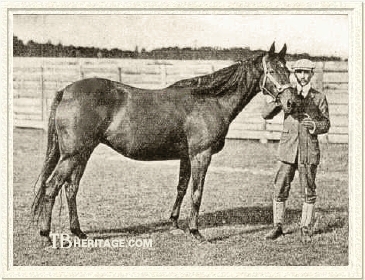 |
|
|
German breeders made great strides in the development of their thoroughbred breeding and racing stock in the late nineteenth and early twentieth centuries, owing in large part to the importation of high quality stock from England and France. Stallions of the caliber of Galtee More, Ard Patrick, Caius, and Dark Ronald arrived for stud service in Germany, as did dozens of mares, among them the English-bred Festa.
Festa became one of the most important mares in German breeding history, despite producing only five live foals during her tenure in Germany. Of those five foals, four were colts, only two of which enjoyed normal life spans, as one son died young and another never lived to serve at stud. Festa’s sole daughter produced very few foals before her own early death. Nevertheless, Festa became the ancestress of nearly forty individual German classic winners in the period from 1906, when her son Fels won the Deutsches Derby, to the early 1940s. Many of these classic-winning descendants carried more than one cross of Festa in their pedigrees through the practice popular in Germany at the time of inbreeding to superior individuals.
The pedigree of Festa was hard to fault. She was a daughter of the unbeaten racehorse St. Simon, the most dominant English stallion at the turn of the twentieth century. At the time of her birth, St. Simon was already the sire of four winners of six English classic races. All had been fillies, and another, Mrs. Butterwick, would win yet another classic race that spring.
Festa's dam was L'Abbesse de Jouarre (1886), a small black filly purchased for £300 at the Doncaster sales by the Irish peer Wyndham Thomas Windham-Quin, (4th) Earl Dunraven and Mount-Earl, and his racing partner, Lord Randolph Churchill. She was a daughter of Trappist, by Derby winner Hermit. Trappist was a durable sprinter, accounting for the July Cup, All-Aged Stakes, Goodwood's Steward's Cup and twenty-one other races during his racecourse career. L'Abbesse de Jouarre's dam, Festive (by Carnival), a small, weedy filly that won one small race, was a member of the Agnes branch of Family #16.
|
| 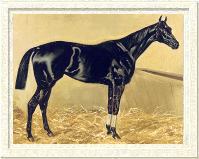
L'Abbesse de Jouarre
|
|
L'Abbesse de Jouarre was a "gallant little thing, with a heart bigger than her body." In addition to winning the Epsom Oaks, she took the Manchester Cup at age four, and Ascot's Hardwicke Stakes at five. She produced only three foals: a Galopin colt named Cowl, which amounted to nothing, and full siblings by St. Simon, the filly Festa (1893) and her younger brother Desmond (1896). Desmond was a good juvenile winner that could not place at age three, but he was a successful stallion at Lord Dunraven's Fort Union Stud in Ireland. He was noted for his precocious juvenile offspring, but he also got some game stayers, and was leading sire in England in 1913, the year of his death. L'Abbesse de Jouarre died in the spring of 1897 at Welbeck while delivering a dead foal by Isinglass.
|
Festa was a small, light-framed brown filly. She did not have the big shoulder or powerful hindquarters of her younger brother, Desmond, nor did she possess his willful temperament. In looks, she was definitely her mother's daughter: "small," said her later German purchaser, "though full of quality." Racing ability was another matter.
Festa on the Turf
Festa failed to win in five tries as a two-year-old, though she did finish second in the Fitzwilliam Plate at Newmarket and third in the Brocklesby Stakes at Lincoln. At three, Festa participated in fourteen races. She won the Bevendean Handicap, run over six furlongs at Brighton, and at Doncaster, in the Melton Stakes, finished in a dead-heat for the victory. She was handily defeated in the run-off, however. She placed second in Nottingham's Bestwood Handicap, and third in Northampton's Earl of Spencer Plate, Hurst's August Handicap and Saturday Handicap, in the Lenton Fir Plate at Nottingham, and in the Ashcombe Handicap at Lewes. At four, Festa raced three times, winning the five furlong Wilton Handicap at Manchester, finishing third in Lincoln's Brocklesby Trial Stakes, and unplaced once. All told, Festa raced twenty-two times and garnered two-and-a-half victories.
Festa was retired to the broodmare paddocks at the Earl of Dunraven's Fort Union Stud in Kildare, Ireland.
Festa in the Breeding Shed
Festa's first foal arrived in 1899, a colt by Winkfield, which was later gelded. The next year came a colt by Carbine. Named Salute, he was also gelded, but won several races for the Earl of Dunraven. Her last foal for the Earl was the Ayrshire filly Festal Air (1901). Festal Air made no name for herself on the racecourse and had a tragically brief career at stud. She was barren to Wildfowler, and died in 1906 shortly after foaling a colt by Laveno named Rhinefall.
Festa was covered again by Ayrshire and sent to the Newmarket sales in 1901. "Nervous and sweating" in her stall, she was viewed several times by Ulrich von Oertzen, a representative of the German Breeding Society who had served under Georg von Lehndorff and was an annual visitor to the Newmarket sales. The Society regularly purchased horses at Newmarket, some for the national stud, and some for resale to private breeders to improve the overall quality of horses in Germany. Von Oertzen was hesitant about purchasing Festa: "I had made up my mind when I went to the Newmarket Sales, after having examined carefully her pedigree and her not very tempting racing record, to buy her; but I must confess I hesitated when I saw the mare because she was small...I doubted if the German critics, who always want big animals who can pose as models for a painter but are of no use as racehorses, would agree with my selection. Then I remembered that Count Lehndorff, my old master, had bought Pulcherrima for the Government's Stud of Graditz, although she was not bigger than Festa, simply because she was so very well bred, and so I bought Festa for 1,000 guineas, and I considered that a cheap price even in those times. I must mention that I was confirmed in my disposition to buy this mare through an intimation coming from Dr. von Weinberg that he would bid for her if she was put up for sale in Germany."
Von Oertzen purchased her privately from Dunraven for the sale minimum, and off Festa went to Germany, where Arthur Weinberg, true to his word, bid on her at auction, and obtained her for £500. Arthur and Carl Weinberg were masters of Gestüt Waldfried near Frankfort-am-Main, Germany. The Weinberg brothers were sons of the industrialist Bernhard Weinberg. Arthur, the elder of the brothers, studied physics, mathematics, and chemistry at university, and in 1883, along with brother Carl, joined the firm of Farbenfabrik Leopold, Cassella, & Co. During the course of his career there, Arthur was credited with discovering multiple methods of making synthetic dyes. Brother Carl created and ran the pharmaceutical department of the company. Arthur was renowned as a violinist and organist, while Carl was an avid art collector. Lovers of sports, the brothers embarked on breeding thoroughbreds in 1895 at the farm they founded, Gestüt Waldfried, which soon became one of the premier studs in Germany. The brothers were ennobled by Kaiser Wilhelm II in 1908, and henceforth were known as Arthur and Carl von Weinberg.
|
| 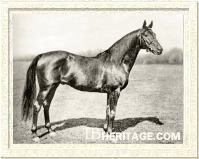
Festino
|
|
The purchase of Festa reaped an immediate dividend, for the Ayrshire foal she was carrying turned out to be the brown colt FESTINO (1902), a racehorse of the highest class.
FESTINO won eighteen of thirty-one starts during his racing career. At age three, he captured the Union-Rennen at Hoppegarten and was a courageous second to the brilliant Austrian mare Patience in the Deutsches Derby at Hamburg. At four, FESTINO took the Hansa Preis at Hamburg and the Grosser Preis von Berlin at Hoppegarten. He retired with over 300,000 marks in prize money.
|
At stud, FESTINO was very successful, making his early death in 1915 at the age of thirteen a severe blow to German breeding. The progeny of Festino included Orelio (1911, out of Ormelva, by Orme), winner of the Preis des Winterfavoriten at two in 1913 and the Grosser Preis von Berlin at three; Festtarok (1909, out of Tartey), victorious in four races, including the 1914 Goldene Peitsche; Antinous (1912, from Anmut, by Saraband), winner in 1915 of the Henckel-Rennen (German Two Thousand Guineas) at Hoppegarten; Amorino, a full brother to Antinous, winner of the Deutsches Derby a year later; and Pergolese (1914, out of Perfect Love, by Persimmon), winner in 1917 of the Hansa Preis. Amorino raced twice after his Derby win, but without success. He was sold and later in his career raced over hurdles. He died in training.
Pergolese's offspring included Augias (1920, from Augusta Charlotte, by FELS), winner at two in 1922 of the Zukunfts-Rennen at Baden-Baden, and at three, of the Deutsches Derby, Henckel-Rennen, Union-Rennen. Augias also took laurels in the Grosser Preis von Hamburg, Hoppegartener Jubiläums-Preis, and twice won the Grosser Preis von Berlin. At stud, Augias failed to get anything approaching his own ability, but did become the broodmare sire of Orator (1938, by Athanasius), the sire of four classic winners in Germany. Woher (1925), a filly by Pergolese, was of interest not because of any prowess on the racecourse, but because of her color, being a rare registered white Thoroughbred.
|

Fels
|
|
The second in the trio of Festa's fine racing sons who went on to become a top stallion was FELS (1903), a brown colt by the German-bred stallion Hannibal. He was a stunningly handsome individual, with a white right front foot, three white socks, and a star on his forehead and a broad splash of white around his muzzle. He was compact and muscular, blessed with brilliant speed and the stamina to stay the classic distance of 1-1/2 miles. During his career, FELS won eighteen of his twenty starts between the ages of two and four.
|
At two, FELS' wins included the Zukunfts-Rennen, the Ratibor-Rennen at Hoppegarten, and the Preis des Winterfavoriten at Koln. At three, FELS took down the Henckel-Rennen, and then was shipped to Vienna for the Österreichisches Derby. He ran a courageous race to come in second to the Hungarian-bred Morpeth. Back home, in front of a crowd that included Kaiser Wilhelm II, FELS redeemed himself with a convincing victory in the Deutsches Derby. At four, he scored victories in the Hansa Preis and the Grosser Preis von Berlin. His only other loss came at three in the Hoppegartener Jubiläums-Preis, in which he finished second to Ignis. With only two losses, Fels had arguably been the most dominant German racehorse for three seasons. His earnings were a healthy 417,000-plus marks. Expectations were high for him when he embarked on his stud career at Gestüt Verwaltung near Frankfort-am-Main.
FELS sired horses who could sprint and who could stay the classic distances. His classic winners included Pallenberg (1917, out of Our Favorite, by Jaquemart), winner in 1920 of the Henckel-Rennen; Lentulus (1919, from Letizia, by Ard Patrick), victor in 1922 of the Henckel-Rennen, Union-Rennen, and placed second in the Deutsches St. Leger; the speedy filly Ischida (1920, out of Illustra, by Collar), victress the following year, 1923, in both the Kisasszony-Rennen (One Thousand Guineas) at Hoppegarten and Goldene Peitsche, a six furlong sprint at the same track.
Ossian (1918, out Osella, by Orme) was another top class performer by FELS, winner in 1921 of the Deutsches St. Leger, Grosser Preis von Berlin, Grosser Preis von Baden, and second in the Deutsches Derby. During his career, Ossian also captured the Grosser Preis von Koln and the Grosser Preis von Hannover. Ossian was exported to Czechoslovakia for stud, and did well there, siring Oskar, winner in 1931 of the Ceske Derby and Tornado, dual classic winner in 1937 of the Velka Jarni Cena (Two Thousand Guineas) and Ceske Derby. The winner of the Ceske Derby the year previous to Tornado, Napoli, was from a daughter of Ossian.
Other good stakes winners by FELS included Rosendame (1921, out of Rose Verte, by Elf II), winner of the 1923 Zukunfts-Rennen; that filly's full brother Rosenritter (1916), winner of the Podbielski-Rennen and second in the Grosser Preis von Berlin; Sankt Felix (1926, out of St. Louise, by Ladas), winner of the Alagi dij in Hungary; Fundin (1921, from Florise, by Talion), winner of the Union-Rennen, Preis der Stadt Frankfurt and Hohenlohe-Oehringen-Rennen; and Merlan (1920, out of Metope by FESTINO), winner of the 1922 Schwarzwald-Rennen at Baden-Baden. Another good winner by FELS was the colt Harlekin (1914, from Hecuba, by Cazabat), winner of twenty-eight races. He was exported to Poland for stud duty, and among his winners was Jawor, winner of the Nagroda St. Leger in 1933.
As a sire of broodmares, FELS enjoyed considerable success. Daughters of Fels who produced German classic winners included Augusta Charlotte (1915, out of Anmut, by Saraband), dam of the aforementioned Deutsches Derby champion Augias, and Gravitas (1922, out of Grolle Nicht, by FERVOR), dam of Gregor (by Pergolese), winner of the 1930 Deutsches St. Leger and five other stakes, including the Hoppegartener Jubiläums-Preis. FELS' daughter Ladylove (1913), a winner of the Goldene Peitsche, produced two sterling performers -- Lampos (by FERVOR), winner in 1926 of the Deutsches St. Leger and ten other races in his career, and Ladro (1927, by FERVOR'S son Graf Ferry), winner of the Zukunfts-Rennen and Ratibor-Rennen at two in 1929, and second in the Henckel-Rennen and Deutsches Derby the following year. Both Lampos and Ladro later got classic winners in Germany.
FELS' daughter Orkade (1909, from Ormelva by Orme) won the Schwarzwald-Rennen at Baden-Baden at two and twice won a race named in honor of her granddam, the Festa-Rennen at Berlin. Orkade became the dam of Omen, winner in 1921 of the Deutsches Derby. FELS' daughter Blaue Blum (1923, out of Blaustrumpf, by Saphir) produced Blasius (1934, by Aurelius), winner in 1937 of the Union-Rennen, Braunes Band von Deutschland and second in the Deutsches St. Leger. Blaue Blum's daughters were also major producers, making her the second dam of Baal, winner of the Grosser Preis von Baden and of Baalim, winner in 1961 of the Deutsches Derby and Deutsches St. Leger. Another daughter of Blaue Blum, the Aurelius mare Blumenkrone, produced classic-placed Blumenprinz and she was also second dam of Deutsches St. Leger victor Bernardus. After remaining dormant for many decades, the family of Blaue Blume produced the Deutsches Derby winner Belenus (by Lomitas) in 1999. That same season, Belenus took the Preis von Europa at Koln and the BMW Euro Champion at at the Hoppegarten track. Sold for stud duty to the Golejewko Stud in Poland, Belenus numbers among his progeny the filly Kardinale, winner in 2010 of the Nagroda (Polish) St. Leger.
The best sire son of FELS was undoubtedly Laland. Foaled in 1913, he was a half-brother to Preis der Diana winner Ladylike, the dam of FELS' daughter Ladylove. Laland sired a winner of the Grosser Preis von Baden in Agalire, and four German classic winners: Libertas (1927 Preis der Diana winner), Mio Darezzo (winner in 1932 of the Deutsches St. Leger), and the peerless filly Nereide. Foaled in 1932, she was out of Italian-bred Nella da Gubbio, by Grand Parade, and so in-bred to L'Abbesse de Jouarre through both Desmond and Festa. Nereide, a winner of the Deutsches Derby and Preis der Diana and undefeated in ten races at ages three and four, later produced full brothers by Oleander: Nuvolari, winner of the Hansa Preis, and Nordlicht, winner of both the Deutsches and Österreichisches Derbies.
FELS was humanely put down at the age of twenty-two in 1925. He was the last successful stallion in the tail-male branch descending from English Derby winner Wild Dayrell, a line nurtured in Hungary and then in Germany with leading sires in four successive generations. Although he did not stand stud at Gestüt Waldfried, the farm honored him in death by having his skeleton brought back to them and put on display.
|
| 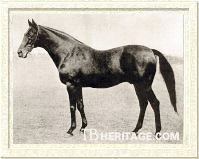
Fervor
|
|
FERVOR (1906), by Galtee More, was the third important racing and sire son of his dam. He raced a total of fifty-seven times from ages two through five, winning nineteen and placing a further thirty times. His major victories came in the Preis des Winterfavoriten at two, the Henckel-Rennen and Deutsches St. Leger (dead heat with the Ard Patrick filly Glockenspiel) at three, the Grosser Preis von Berlin at four, and the Goldene Peitsche at five. His total winnings amounted to 432,590 marks.
|
FERVOR stood stud at the farm of his birth, Gestüt Waldfried. Little came of his early crops due to the limited opportunity wrought by World War I. The 1920s, however, saw FERVOR emerge as one of the most dominant stallions in Germany. He was leading sire in Germany four straight years, 1923 through 1916. Four performers by Fervor swept four of the major German classics in 1924 -- Anmarsch (out of Amanda, by St. Amant) captured the Deutsches Derby, Petunie (from Perilla, by Cyllene) the Kisasszony-Rennen, Ostrea (out of Ostella, by Orme) took the Preis der Diana, and Hornbori (from Hecuba, by Cazabat) won the Deutsches St. Leger.
In addition to the classic winners of 1924, FERVOR sired two other winners of the Preis der Diana -- Aditja (1925, out of Aversion, by Nuage) and Ausflucht (1930, out of Auslese by Pergolese); four other winners of the Kisasszony-Rennen (Romanze (1917, out of Roma, by Matchbox), Faustina (1923, out of Favilla, by Nuage) Ausflucht, and Ausnahme (1926, full sister to Ausflucht). FERVOR also got two winners of the Henckel-Rennen -- Torero (1924, out of Tonga, by FELS) and Favor (a 1922 full brother to Faustina), and one other winner of the Deutsches St. Leger, Lampos.
FERVOR also sired two winners of the Goldene Peitsch -- Optimist (1915, out of Ormelva, by Orme) and Janitor (1930, out of Jane Pierney, by Stefan the Great), the latter winning it twice. Three winners of the Preis des Winterfavoriten were sired by FERVOR: Favor, Graf Ferry (1918, out of Grave and Gay, by Henry of Navarre), and Mellitus (1927, out of Meinung, by Caius). Favor and Graf Ferry themselves were to become good sires, but the male line of Galtee More through FERVOR died out when Deutsches Derby winner Solo, a grandson of FERVOR, failed to get a good son.
FERVOR proved a good sire of broodmares, as well, his daughters producing two winners of the Preis der Diana -- Lehnsherrin (1931, by Herold) and Alderfee (1935, by Ferro); Pelopidas (1931, by Landgraf), a winner of the Henckel-Rennen; and Arjaman (1930, out of FERVOR'S daughter Aditja and by Herold), victorious in both the Deutsches St. Leger and its Hungarian counterpart, the Magyar St. Leger at Budapest. FERVOR died at Gestüt Waldfried at the age of twenty-five in 1931.
|
| 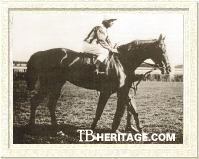
Faust
|
|
The remaining son of Festa was the ill-fated FAUST (1905), a chestnut colt by Saraband. A story pertaining to the conception of Faust relates that the Weinbergs hoped to breed Festa to Epsom Derby winner Ard Patrick, who had recently been purchased for the Imperial Stud at Graditz. The stud manager felt Festa was not good enough to go to Ard Patrick because of her lackluster racetrack form and the fact she was the dam of an as yet unraced two-year-old (FESTINO). She was mated with the ageing Saraband instead. The story may be apocryphal, as Saraband was Germany's leading sire the previous two years, and still a successful stallion.
|
There was no questioning the authenticity of FAUST'S talent once he got to the races. Between the ages of two and four he won eight of nine starts. At two, he was victorious in the Renard-Rennen at Hoppegarten. At three, Faust notched victories in the Austria Preis at Vienna, the Grosser Preis von Baden, Prinz Herrmann von Sachsen-Weimar Mamorial, and Fürstenberg-Memorial at Baden-Baden, Jubiläums-Preis zu Koln and Preis von Rhein at Koln. At four, Faust won the Goldene Peitsche at Hoppegarten, and met his only defeat when finishing third in the Hoppegartener Jubiläums-Preis to Lapis Lazuli, a son of Ard Patrick. Tragically, Faust never got the chance to serve at stud, for he died of a twisted intestine not long after his last race.
|
| 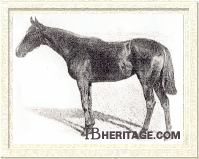
Fabula
|
|
Festa produced only one daughter during her years in Germany, the Hannibal filly FABULA (1904). A full sister to FELS, she was a strong and powerfully built chestnut. Like the other offspring of Festa, FABULA raced as a homebred for Gestüt Waldfried. She ran through the age of four, making sixteen starts, of which she won eleven and over 212,000 marks in prize money. As a two-year-old, her biggest wins came in the Zukunfts-Rennen and the Rennard-Rennen at Hoppegarten. At three, Fabula took laurels in the Henckel-Rennen, Austria Preis, and Bayern-Preis at Munich. At four, her biggest victory came in the Goldene-Peitsche.
|
Upon her retirement, FABULA joined her dam as a broodmare at Gestüt Waldfried, but she was shipped to Ireland for her first breeding, to be covered by Derby and Grand Prix de Paris winner Spearmint. The result was Fabella (1910), a filly that captured the Rennard-Rennen and Preis des Winterfavoriten at two, won the Preis von Rhein at Koln and was second in the Grosser Preis von Berlin at three, and took the Danubia-Rennen at Hoppegarten at four.
Fabella had only one recorded foal, the filly Faida, by Le Meteore, foaled in 1917. Faida was useless on the racecourse, but was a good producer. To the cover of Pergolese, she produced 1932 Preis der Diana winner Faienza. Full siblings to Faienza included Faro (1925), a multiple German stakes winner, and Fides (1926), dam of Finitor, winner of the Ratibor-Rennen. Faienza's only recorded produce was the minor stakes winner Flavier. This branch of the Festa female family has not bred on.
FABULA'S second foal, also a filly, was Favilla, sired by Nuage and foaled in 1912. Favilla only managed to be stakes placed at two in 1914, but did well in the broodmare ranks, with four winners to her credit, including two German classic winners, Favor and Faustina, before her death in 1930.
Favor captured the Preis des Winterfavoriten as a juvenile in 1924 and the Henckel-Rennen at three. His younger sister Faustina, took the Zukunfts-Rennen as a two-year-old in 1925 and the Kisasszony-Rennen at three. Favilla's other two stakes winners were the siblings by Pergolese -- Farinelli (1925) and Farnesina (1920), the latter a winner of the Deutscher Stuten Preis at Hannover.
Favor proved a good sire, one of his best being Cassius (1930, out of Crescendo, by Malua), winner of the Henckel-Rennen in 1933. His sister, Faustina, kept the female line of Festa prominent, for stakes winners were produced from this line for several generations, including Faiblesse (1961) and Felsennelke (1974), both winners of the Deutscher Stuten Preis; Fontanus (1961), winner of the Aral-Pokal and stakes-placed in France; Florino (1968), winner of the Union-Rennen, and First Hello (1992), who won the Deutsches St. Leger in 1995, to name only a very few. Audley Farm in Maryland had a German-bred female line descendant of Festa from whom they bred Feuerbach, by No No Jim. Foaled in 1983, Feuerbach raced in Europe, where he was a stakes winner in Germany and Sweden and group-placed in Italy.
Favor and Faustina were sired by FERVOR, the youngest offspring of Festa, while Farinelli and Farnesina were each sired by Pergolese, a son of Festa's eldest German-bred son, FESTINO. Close inbreeding was not an uncommon practice in Germany at the time, and inbreeding to Festa through various combinations is found in the pedigrees of ten German classic winners between 1923 and 1933. For example, Torero and Lampos were both sired by FERVOR out of mares by his half-brother FELS; Ausnahme and Ausflucht were by FERVOR out of mares by Pergolese; Augias, Aurelius, and Gregor were all by Pergolese out of mares by FELS; and Faienza was by Pergolese out of a granddaughter of FABULA. As late as 1942, the pedigree of the Deutsches St. Leger winner Gradivo carried no less than four crosses of Festa in the fourth generation of his pedigree. Gradivo had an interesting stud career. Exported to Czechoslovakia, he became a top stallion, siring three winners of the Ceske Derby and his daughters produced a further seven winners of the race. Eventually, he was smuggled back into his home country, but was not successful there.
On the eve of World War I, the Weinbergs, as usual, sent several of their mares outside Germany to be covered. FABULA and Ladylike were sent to England. FABULA was mated with William the Third and Ladylike with Willonyx. Both mares were still in England when hostilities broke out and they fell under the auspices of the 1914 "Trading With the Enemy Amendment Act." German-owned bloodstock in Britain was seized. Eventually, at the end of 1916, both mares were sold at a Tattersall's sale at Knightsbridge. FABULA, barren to a cover by Lemberg, was knocked down to Major Waldorf Astor for only 330 guineas. FABULA'S yearling colt by William the Third, named Battalador, was sold to the Marquis de San Miguel of Spain, as was Ladylike. Following her purchase, FABULA was mated with Sunstar. She was kept at Major Astor's Cliveden Stud, and it was there she died. Expected to give birth to her foal by Sunstar in April of 1918, she was found in her paddock with a fractured fetlock. Despite valiant attempts to save her, she had to be humanely destroyed.
The female line of Festa and her daughter FABULA through Favilla is still producing quality performers. The German-bred Ferrari, foaled in 1994, was a multiple stakes winner in Germany before exportation to the United States, where he was Grade I-placed, and his half-sister, Freni, is the dam of the English filly Clowance by Montjeu, winner in 2008 of the Fillies Trial Stakes at Newbury.
Festa never had another live foal after 1906. She came up barren in 1907 and aborted her foal in 1908. She was barren from 1909 until her death from a twisted intestine at the age of twenty-one in 1914. Her overall record as a producer for German breeding was astounding, even by today's standards. Her progeny won seventy-five races and earned a total of over 1,620,000 gold marks, the equivalent of £84,500. At the time of her death, this put her in second place behind the British mare Galicia, whose progeny Bayardo, Lemberg, and Eastern had garnered £88,124. The British were quick to point out, however, that the money won by Festa's progeny included not just first place money, but earnings from placings as well. The British maintained that if their system was used, which took into account only win earnings, then Festa would in actuality have ranked third behind Galicia and the Danish-bred Mowerina, whose progeny, including Donovan, Semolina, Modwena, and Raeburn, amounted to £83,067. Earnings aside, Festa was the dam of three horses who won five German classic races between them, and that was a record that was beyond dispute.
Gestüt Waldfried remained a German breeding power for years after the death of its most famous mare. The advent of the Second World War changed all that. Under the Nazi regime, the Weinberg brothers were persecuted for their Jewish heritage. Arthur was arrested and imprisoned in the Theresienstadt concentration camp, where he died in 1943. His brother Carl died in exile in Italy that same year. The year of the brothers' deaths also saw the demise of the stud they built. The buildings were destroyed and the majority of the horses killed in a bombing raid by the U.S. Air Force. The farm began again on land near Koln under the auspices of Count Rudolf Graf von Spreti, the son-in-law of Arthur von Weinberg. After his death in 1955, Count von Spreti's daughter Alexandra took over the operations of the farm. Now known as Gestüt Altefeld, the stud was purchased by Manfred Graf in 1981. Nearly a quarter century later, in 2005, Gestüt Altefeld presented an exhibition celebrating the 110th anniversary of the founding of Gestüt Waldfried. One of the pictures prominently displayed was the portrait of Festa, above.
-- Elizabeth Martiniak and Bettina Fuchs.
Special thanks to Manfred Graf of Gestüt Altefeld, Georg Lange of the Germany Breeding and Racing Organization, and Anne Peters
|
|
|
|

